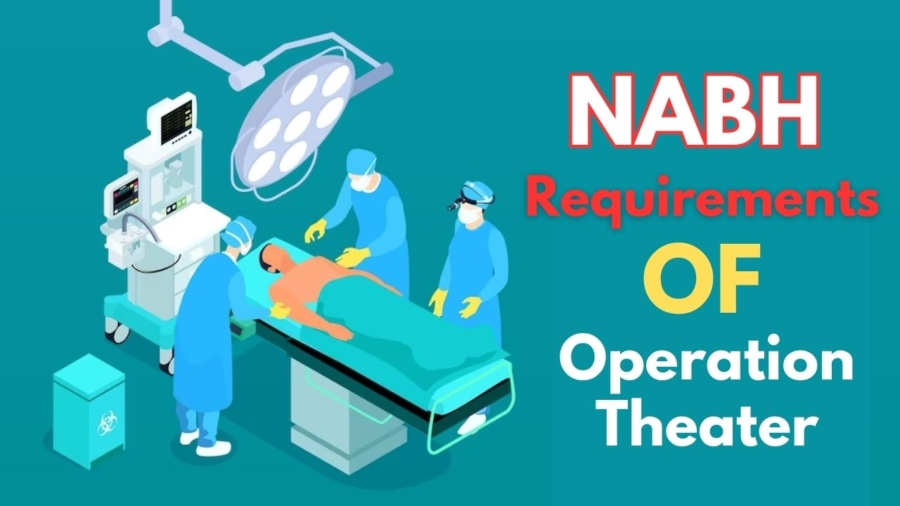The National Accreditation Board for Hospitals & Healthcare Providers (NABH) in India has specific requirements for Operation Theaters (OTs) to ensure quality and safety in healthcare facilities.
Modular Operation Theatre is NOT A MANDATORY REQUIREMENT under any program. It is totally left to HCO whether they want to install it.
For this purpose operation theatres have been divided into two groups:
1. Type A (Erstwhile Super specialty OT): Type A OT means operation theatres for Neurosciences, Orthopaedics (Joint Replacement), and Cardiothoracic and Transplant Surgery (Renal, Liver, heart, etc.).
2. Type B (Erstwhile General OT): This includes operation theatres for Ophthalmology, day-care surgeries and all other basic surgical disciplines.
Type A
1-20 Air Changes Per Hour, including 4 fresh air
2. Air Velocity: The airflow needs to be unidirectional and downwards on the OT table @ 25-35 FPM (feet per minute)
3-Positive Pressure: The minimum positive pressure recommended is 2.5 Pascal (0.01 inches of water). There is a requirement to maintain a positive pressure differential between OT and adjoining areas to prevent outside air entry into OT. Positive pressure will be maintained in OT at all times (operational & non-operational hours)
4. Air handling in the OT including air Quality: Air is supplied through Terminal HEPA (High-Efficiency Particulate Air) filters in the ceiling.
5. Air Filtration: The AHU (i.e. air handling unit) must be an air purification unit and air filtration unit. HEPA filters of efficiency 99.97% down to 0.3 microns or higher efficiency are to be provided.
6. Temperature & Relative Humidity: It should be maintained at 21°C 3°C (except for Joints replacement where it should be 180C � 20C) with corresponding relative humidity between 20 to 60%, though the ideal RH is considered to be 55%. . Air quality at the supply i.e. at grille level should be Class 100/ISO Class 5 (at rest condition). Note: Class 100 means a cubic foot of air should not have more than 0.5 microns or larger.
REQUIREMENTS � Type B (Erstwhile General OT)
The Air quality at the supply i.e. at the grille level should be class 1000/ISO Class 6 ( at rest condition). Note: Class 1000 means a cubic foot of air must have no more than 1000 particles measuring 0.5 microns or larger.
While we can provide some general guidelines, it’s important to note that NABH requirements may evolve over time, so it’s always best to consult the latest official documentation and guidelines provided by NABH for accurate and up-to-date information.
Here are some more key areas typically covered by NABH requirements for OTs:
1. Infrastructure: The OT should have an appropriate physical layout, including adequate space, proper ventilation, lighting, temperature control, and infection control measures. There should be separate OTs for different specialties, and each OT should have an anteroom, scrub area, and changing room.
2. Equipment: NABH emphasizes the availability and maintenance of essential equipment and instruments in the OT. This includes anesthesia machines, surgical lights, operating tables, surgical instruments, patient monitors, and emergency equipment, among others. Regular maintenance and calibration of equipment should be conducted.
3. Staffing: The OT should have appropriately qualified and trained staff, including surgeons, anesthetists, nurses, technicians, and other supporting personnel. Their qualifications, certifications, and training records should be maintained, and staff should be provided with regular training on infection control, emergency procedures, and safety protocols.
4. Infection Control: Stringent infection control practices are vital in OTs. The NABH guidelines stress the implementation of standard precautions, hand hygiene protocols, sterilization and disinfection procedures, waste management, and aseptic techniques. Regular surveillance and monitoring of infection rates should be carried out.
5. Documentation: Comprehensive documentation is essential for maintaining quality standards. This includes maintaining patient records, consent forms, anesthesia records, surgical checklists, equipment maintenance records, incident reports, and policies and procedures manuals.
6. Emergency Preparedness: OTs should have protocols and systems in place to handle emergencies and unexpected situations. This includes emergency drug supplies, resuscitation equipment, trained staff, and well-defined procedures for handling emergencies during surgeries.
7. Patient Safety: The NABH emphasizes patient safety in OTs. This includes patient identification protocols, preoperative assessment, correct site marking, time-out procedures before surgeries, prevention of wrong surgeries, prevention of retained foreign objects, and safe medication practices.
8. Quality Improvement: OTs should have a system for continuous quality improvement. This involves periodic audits, clinical indicators monitoring, adverse event reporting, analysis of incidents, and implementation of corrective and preventive actions.
These are some general areas covered by NABH requirements for OTs. However, it’s crucial to consult the official NABH documentation for the most accurate and up-to-date guidelines, as the requirements may vary or change over time.
For more info join our Facebook group for regular tips on Hospital business and challenges. You can subscribe to our YouTube channel if you want to know How to grow your hospital business


